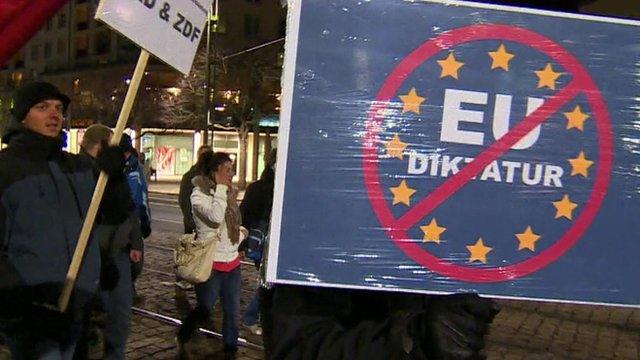Has xenophobia risen in modern Germany?
- Published

Pegida attracts large numbers to its rallies
After nine years of following her every move, many political commentators in Berlin have grown bored and frustrated by Angela Merkel.
They accuse the leader of Europe's biggest nation of constant triangulation and of a lack of strong leadership.
Angela the Hesitant is one of her friendlier nicknames.
Or at least it used to be.
Imagine the surprise when the German chancellor used her annual television address on New Year's Eve for a strong denunciation of a growing wave of anti-foreigner demonstrations.
She didn't mention Pegida, the German acronym for "patriotic Europeans against the Islamisation of the West", but everybody knew to whom Mrs Merkel was referring.
"Too often their hearts are cold, and nurse prejudices or even hatred," she said.
After the Paris mass murder - 17 people died last week in attacks on Charlie Hebdo magazine, a Jewish supermarket and a policewoman - Mrs Merkel followed up and attended a vigil organised by a German Muslim group at the Brandenburg Gate in Berlin.
"I am the chancellor of all Germans. Islam is part of Germany," she said.
Taking a risk
Whatever one makes of the conservative leader's utterances - there is no doubt that Mrs Merkel is taking an electoral risk.
Traditionally, her Christian Democratic Union (CDU) and particularly its Bavarian sister party, Christian Social Union (CSU), have tried very hard not to give rise to a party to their right.
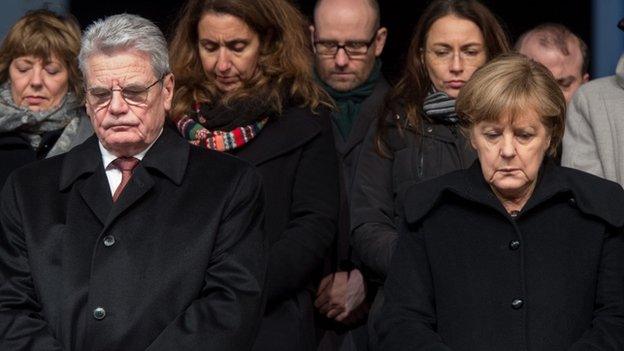
Chancellor Merkel has spoken out against racial hatred
So when the peaceful Pegida marches first started back in the autumn, a lot of conservative politicians stressed the importance of dialogue and declared themselves willing to understand the underlying causes of protesters' fears.
After all, the Eurosceptic Alternative fur Deutschland (AfD), who share a group with the British Conservatives in the European Parliament much to Mrs Merkel's annoyance, has recently made inroads into traditional conservative voters, not least in the former Communist East of the country.
There is talk of an alliance, external between AfD and Pegida already.
And an opinion poll by YouGov before Christmas found that a third of Germans agreed with some of Pegida's points, particularly the scepticism towards Muslim immigration.
Some observers worry Mrs Merkel may have raised Pegida's profile further by taking their xenophobic views head-on.
The chancellor, better aware than most of the way Germany is watched carefully around Europe, clearly thought differently.
So what exactly is Pegida?
Rise of Pegida
The group was founded in Dresden, where a small march of a few hundred has snowballed into weekly Monday demonstrations by - at the last count - 25,000 people.
The attempt of Germans elsewhere to imitate this success as Bargida (Berlin), Kogida (Cologne) or Legida (Leipzig) has failed miserably - never more than a few hundred people were often dwarfed by the numbers on protest marches, which have been organised with increasing frequency.
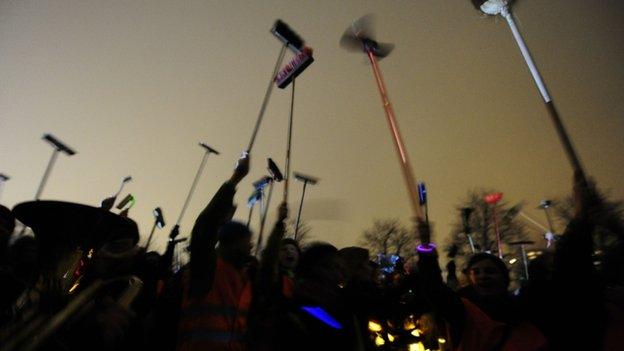
Anti-Pegida demonstrators make their point with brooms
More than 100,000 in many cities, both East and West, demonstrated for a diverse, tolerant Germany with a generous attitude to refugees - about 200,000 reached the country last year from war-torn Syria alone.
The housing of asylum-seekers is often badly managed and places great strain on some communities, where they tend to reside in the poorer parts of a town or village.
Yet, according to a study by Dresden's technical university, the attitude of Pegida marchers goes beyond hostility towards immigration and asylum problems.
Not even a quarter of the roughly 400 participants questioned on one of the last three demonstrations declared themselves worried about Islam.
Most, however, talked about a general disillusionment with politics and the media.
While two out of three marchers refused to talk to the scientists, thereby imitating the explicit refusal of the organisers to speak to the media, those who did talk came from a solid lower-middle-class background:
most were male, with no religion or political party affiliation
70% were in employment
85% lived in the region of Saxony, of which Dresden is the capital
Local pride
A lot of Germans take great pride in their birthplaces, regional accents are cultivated in all echelons of society, a little banter about "the most beautiful place" and "the hippest city" seems almost inevitable whenever people from different regions meet.
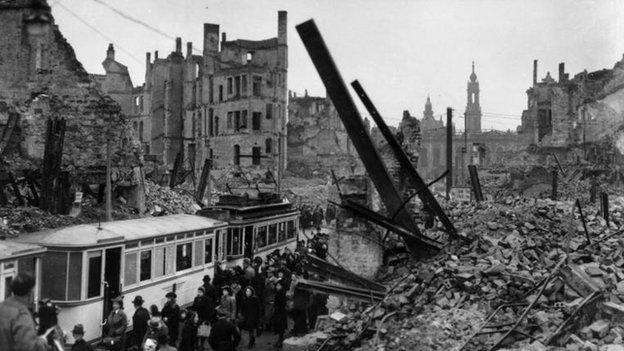
Dresden was devastated by Allied bombing in 1945
Like the inhabitants of Hamburg, Cologne or Munich, Dresdeners express tremendous local pride - nowhere else could life be better than in their home town.
"People from Cologne say similar things," says Peter Carstens, who was born in the cathedral city on the Rhine and spent four years in Dresden as a correspondent for Frankfurter Allgemeine before moving to Berlin.
"The difference is, in Cologne you are allowed to dispute the claim."
Many Dresdeners, on the other hand, remain convinced of the uniqueness of their own city.
There are historical reasons for that, both good and bad.
Hundreds of years ago, civic pride in Dresden was symbolic of the townspeople's determination to hold on to their traditions and values.
The town was Protestant, the court of Augustus the Strong (1694-1733) and his successors was Catholic.
The uneasy cohabitation resulted in a competition as to which party could add the most beautiful building to the town's skyline.
Allied bombing
The protestant Frauenkirche, finished in 1743, became not just a prime example of baroque architecture but a symbol of Dresdeners' autonomy.
So the collapse of the church's dome, two days after the devastating British bombing raids, external on 13 February 1945, shattered not just a spectacular building.
The ruins of the Frauenkirche became a symbol for a particular kind of dogged civic pride and the focus of peace demonstrations, which were not controlled by the Communist rulers.
It culminated in the reconstruction of the building, supported by generous private donors not least from Britain and the US.
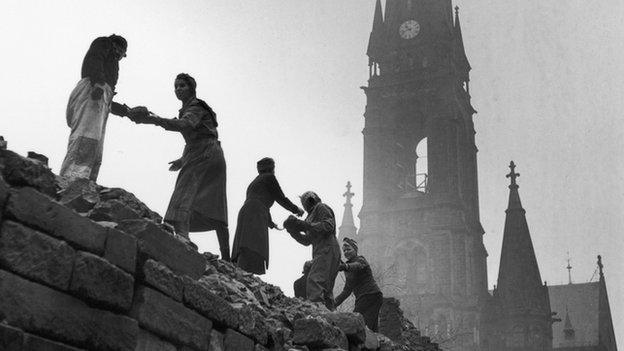
A huge reconstruction effort was required to rebuild Dresden
In fact, a lot of British efforts devoted to the post-War reconciliation were focused on Dresden.
By singling out the undoubtedly very beautiful Eastern city as a symbol for many, often more damaged, places in Germany, they unwittingly followed in the footsteps of Joseph Goebbels.
In the last months of the war, Hitler's propaganda minister talked up the "Allied war crime" to inspire an even more dogged defence of the Fatherland against the invading troops, particularly from Soviet Russia.
"Nazi propaganda celebrated its last success," says the military historian Rolf-Dieter Muller - not least with an unscrupulous manipulation of casualty figures.
While police experts in Dresden concluded the most likely number of deaths to be 25,000, Goebbels increased that horrendous figure tenfold.
The Communist rulers of East Germany perpetuated the myth, as did well-meaning British observers who chose Dresden as the symbol of the horrors of aerial war and a centre for post-War reconciliation.
Thus the already well-established exceptionalism of Dresdeners was reinforced by outsiders.
The War casualties, macabre though it may seem, have become a totemic figure, and no expert opinion will sway the hardcore from the perceived special place of their town.
There is very little talk of Dresden as an integral part of the Nazis' war machine, a railway hub to the Eastern front.
The local gauleiter, Martin Mutschmann, was one of the most vocal anti-semites, Dresden's Jews suffered just as much if not more than in other places in the Reich.
Racism and violence
Since re-unification, foreigners have been hunted and killed by neo-Nazi thugs, the hooligans of the local football club are notorious for their violence.
When a racist German knifed, external an Egyptian scientist to death in a Dresden court-house in 2009, the police initially didn't aim for the blond perpetrator. Instead, they shot and injured the victim's dark-skinned husband, who had tried to come to her rescue.
There is no point extrapolating from terrible crimes of individuals to the attitude of a whole city.
But it is true to say that what counts for many Dresdeners, at least those marching with Pegida, is the status of their "beautiful city" as a victim not a perpetrator.
When a commission of respected historians, led by Mr Muller, concluded in 2007 the casualty figure of February 1945 to indeed be 25,000 (plus or minus 20%), a lot of Dresdeners refused to accept the result.
The disdain for undisputable facts, presented by experts, bears more than a passing resemblance to the casual way that Pegida representatives dismiss the statistics of foreigners or indeed Muslims living in Germany.
Immediately after the fall of the Wall, the commemoration of the terrible events of February 1945 was hijacked by Neo-Nazis.
Patiently and steadfastly, Dresden civic society regained "their" date as a symbol for peace and reconciliation.
To deal with Pegida and the damage it does to their beautiful city's reputation, the decent majority will have to manage a similar turnaround.
Organisations helping foreigners already report an increase in the number of volunteers - people seem to follow the chancellor's call for help.
@sebastianborger is the London correspondent for Berliner Zeitung.
- Published13 January 2015

- Published13 January 2015
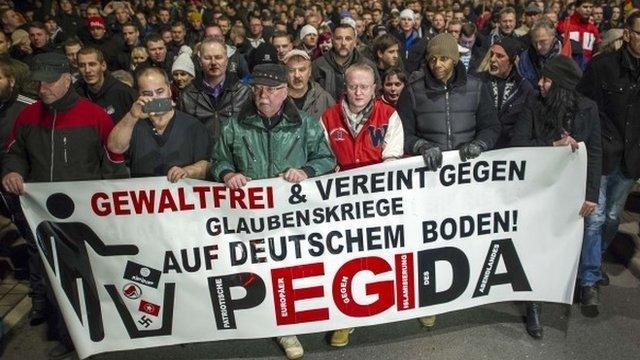
- Published13 January 2015
